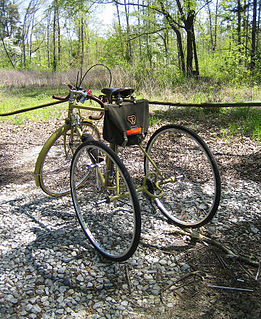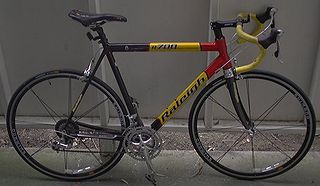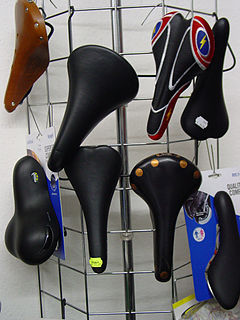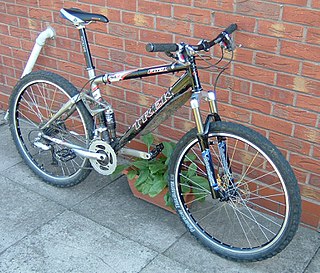
A bicycle, also called a bike or cycle, is a human-powered or motor-powered, pedal-driven, single-track vehicle, having two wheels attached to a frame, one behind the other. A bicycle rider is called a cyclist, or bicyclist.

The tandem bicycle or twin is a form of bicycle designed to be ridden by more than one person. The term tandem refers to the seating arrangement, not the number of riders. Patents related to tandem bicycles date from the mid 1880s. Tandems can reach higher speeds than the same riders on single bicycles, and tandem bicycle racing exists. As with bicycles for single riders, there are many variations that have been developed over the years.

A mountain bike (MTB) or mountain bicycle is a bicycle designed for off-road cycling. Mountain bikes share some similarities with other bicycles, but incorporate features designed to enhance durability and performance in rough terrain. These typically include a suspension fork, large knobby tires, more durable wheels, more powerful brakes, straight, extra wide handlebars to improve balance and comfort over rough terrain, lower gear-ratios for climbing steep grades and sometimes rear suspension to really smooth out the trail.

A recumbent bicycle is a bicycle that places the rider in a laid-back reclining position. Most recumbent riders choose this type of design for ergonomic reasons: the rider's weight is distributed comfortably over a larger area, supported by back and buttocks. On a traditional upright bicycle, the body weight rests entirely on a small portion of the sitting bones, the feet, and the hands.

A tricycle, often abbreviated to trike, is a human-powered three-wheeled vehicle.

A bicycle frame is the main component of a bicycle, onto which wheels and other components are fitted. The modern and most common frame design for an upright bicycle is based on the safety bicycle, and consists of two triangles: a main triangle and a paired rear triangle. This is known as the diamond frame. Frames are required to be strong, stiff and light, which they do by combining different materials and shapes.
The Cannondale Bicycle Corporation is an American division of Canadian conglomerate Dorel Industries that supplies bicycles. It is headquartered in Wilton, Connecticut with manufacturing and assembly facilities in Taiwan.

A utility bicycle,city bicycle, urban bicycle, European City Bike (ECB), classic bike or simply city-bike, is a bicycle designed for frequent short, moderately paced rides through relatively flat urban areas. It is a form of utility bicycle commonly seen around the world, built to facilitate everyday riding in normal clothes in a variety of weather conditions. It is therefore a bicycle designed for practical transportation, as opposed to those primarily for recreation and competition, such as touring bicycles, racing bicycles, and mountain bicycles. Utility bicycles are the most common form globally, and comprise the vast majority found in the developing world. City bikes may be individually owned or operated as part of a public bike sharing scheme.

A racing bicycle, also known as a road bike, and once popularly known as a ten speed, is a bicycle designed for competitive road cycling, a sport governed by and according to the rules of the Union Cycliste Internationale (UCI). The UCI rules were altered in 1934 to exclude recumbent bicycles.

Vehicles for human transport that have two wheels and require balancing by the rider date back to the early 19th century. The first means of transport making use of two wheels arranged consecutively, and thus the archetype of the bicycle, was the German draisine dating back to 1817. The term bicycle was coined in France in the 1860s, and the descriptive title "penny farthing", used to describe an "ordinary bicycle", is a 19th-century term.

Brompton Bicycle is a British manufacturer of folding bicycles based in Greenford, London.
Keith Bontrager is a motorcycle racer who became a pioneer in the development of the modern mountain bike. Between 1980 and 1995, he was president of his own Bontrager Company, which continues to develop components for Trek Bicycle Corporation after Trek bought out Bontrager.

A bicycle saddle, often called a bicycle seat, is one of five contact points on an upright bicycle, the others being the two pedals and the two handles on the handlebars. At any point in time there can be one, two, three, four or five contact points between rider and bike sharing support of rider body weight and applying rotation torque to the pedals. The bicycle saddle has been known as such since the bicycle evolved from the draisine, a forerunner of the bicycle. It performs a similar role as a horse's saddle, not bearing all the weight of the rider as the other contact points also take some of the load.

Bicycle suspension is the system, or systems, used to suspend the rider and bicycle in order to insulate them from the roughness of the terrain. Bicycle suspension is used primarily on mountain bikes, but is also common on hybrid bicycles.

The Raleigh Bicycle Company is a British bicycle manufacturer based in Nottingham, England and founded by Woodhead and Angois in 1885. Using Raleigh as their brand name, it is one of the oldest bicycle companies in the world. After being acquired by Frank Bowden in December 1888, it became The Raleigh Cycle Company, which was registered as a limited liability company in January 1889. By 1913, it was the largest bicycle manufacturing company in the world and since then the quality has declined. From 1921 to 1935, Raleigh also produced motorcycles and three-wheel cars, leading to the formation of Reliant Motors. Raleigh bicycle is now a division of the Dutch corporation Accell.

Mikael Pedersen was a Danish inventor much associated with the English town of Dursley. He is chiefly known today for the highly distinctive Pedersen bicycle. His story is one of rags to riches and back again, and he was largely forgotten in his native country, but fans of the Pedersen bicycle arranged for him to be reburied and a memorial erected at Dursley.

The following outline is provided as an overview of and topical guide to bicycles:

A folding bicycle is a bicycle designed to fold into a compact form, facilitating transport and storage. When folded, the bikes can be more easily carried into buildings, on public transportation, and more easily stored in compact living quarters or aboard a car, boat or plane.























